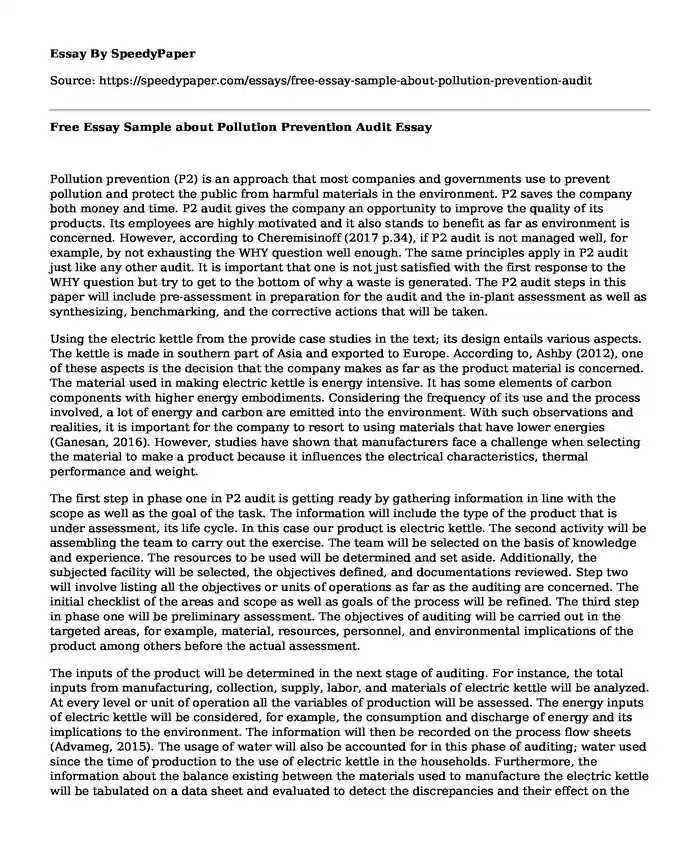Pollution prevention (P2) is an approach that most companies and governments use to prevent pollution and protect the public from harmful materials in the environment. P2 saves the company both money and time. P2 audit gives the company an opportunity to improve the quality of its products. Its employees are highly motivated and it also stands to benefit as far as environment is concerned. However, according to Cheremisinoff (2017 p.34), if P2 audit is not managed well, for example, by not exhausting the WHY question well enough. The same principles apply in P2 audit just like any other audit. It is important that one is not just satisfied with the first response to the WHY question but try to get to the bottom of why a waste is generated. The P2 audit steps in this paper will include pre-assessment in preparation for the audit and the in-plant assessment as well as synthesizing, benchmarking, and the corrective actions that will be taken.
Using the electric kettle from the provide case studies in the text; its design entails various aspects. The kettle is made in southern part of Asia and exported to Europe. According to, Ashby (2012), one of these aspects is the decision that the company makes as far as the product material is concerned. The material used in making electric kettle is energy intensive. It has some elements of carbon components with higher energy embodiments. Considering the frequency of its use and the process involved, a lot of energy and carbon are emitted into the environment. With such observations and realities, it is important for the company to resort to using materials that have lower energies (Ganesan, 2016). However, studies have shown that manufacturers face a challenge when selecting the material to make a product because it influences the electrical characteristics, thermal performance and weight.
The first step in phase one in P2 audit is getting ready by gathering information in line with the scope as well as the goal of the task. The information will include the type of the product that is under assessment, its life cycle. In this case our product is electric kettle. The second activity will be assembling the team to carry out the exercise. The team will be selected on the basis of knowledge and experience. The resources to be used will be determined and set aside. Additionally, the subjected facility will be selected, the objectives defined, and documentations reviewed. Step two will involve listing all the objectives or units of operations as far as the auditing are concerned. The initial checklist of the areas and scope as well as goals of the process will be refined. The third step in phase one will be preliminary assessment. The objectives of auditing will be carried out in the targeted areas, for example, material, resources, personnel, and environmental implications of the product among others before the actual assessment.
The inputs of the product will be determined in the next stage of auditing. For instance, the total inputs from manufacturing, collection, supply, labor, and materials of electric kettle will be analyzed. At every level or unit of operation all the variables of production will be assessed. The energy inputs of electric kettle will be considered, for example, the consumption and discharge of energy and its implications to the environment. The information will then be recorded on the process flow sheets (Advameg, 2015). The usage of water will also be accounted for in this phase of auditing; water used since the time of production to the use of electric kettle in the households. Furthermore, the information about the balance existing between the materials used to manufacture the electric kettle will be tabulated on a data sheet and evaluated to detect the discrepancies and their effect on the environment.
Lastly, recommendations on the cost of manufacturing and the environmental hazard of the product will be formulated. They will be based on the wastes generated by the electric kettle in the environment (carbon and heat discharge) and their implications as well as the remedies. Options for a long-term strategy of reducing waste will be developed and an action plan will be developed and implemented.
References
Advameg, Inc. (2015). How products are made: Volume 5 - aluminum. Retrieved from http://www.madehow.com/Volume-5/Aluminum.html
Ashby, M. F. (2012). Materials and the environment: eco-informed material choice. Elsevier.
Cheremisinoff, N. P. (2017). Industrial liquid filtration equipment. In Fibrous Filter Media (pp. 27-50).
Ganesan, K., Dupont, R., & Theodore, L. (2016). Pollution Prevention: Sustainability, Industrial Ecology, and Green Engineering. CRC Press.
Cite this page
Free Essay Sample about Pollution Prevention Audit. (2022, Jun 09). Retrieved from https://speedypaper.com/essays/free-essay-sample-about-pollution-prevention-audit
Request Removal
If you are the original author of this essay and no longer wish to have it published on the SpeedyPaper website, please click below to request its removal:
- Pros and Cons of the Criminal Justice System, Free Essay for Students
- Free Essay Sample on Breaking a Negative Norm
- Essay Sample on the Ways Ethical Dilemmas Can Influence the Student as a Leader
- Essay Example for You: National Interests and National State Behavior
- Ramifications of Not Involving Nurse in Implementation of Health Information Technology
- Essay Sample on Labor Relations Comprehensive Questions
- Essay Sample: Effects of Depression in Adolescence and the Prevention
Popular categories





